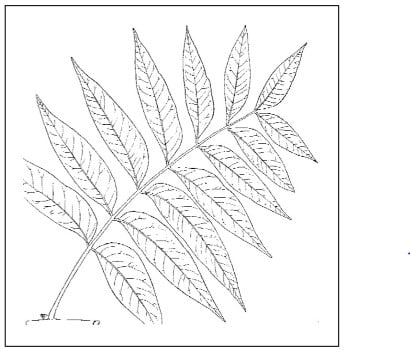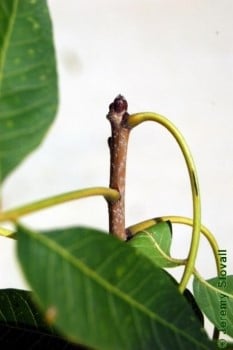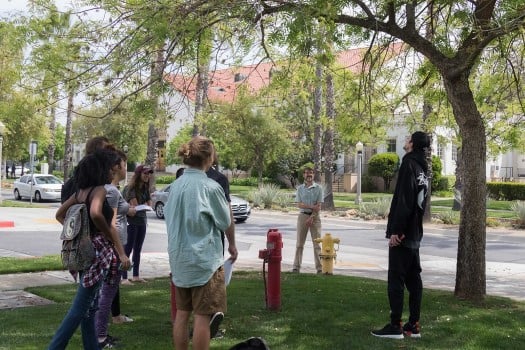University of Redlands Emergency Alert System
Alert Received: . For more information, visit: https://www.redlands.edu/alert/
University of Redlands
- Home
- Trees
- Species Accounts
- Chinese Pistache
Common name: Chinese Pistache(1)
Scientific name: Pistacia chinensis(1)
Family: Anacardiaceae, a group of flowering plants commonly referred to as the cashew family.(1)
Habit: The Chinese Pistache has a moderate growth rate of about 13-24 inches per year and its branches form a vase-shape as they emerge from the trunk.(1,4) Although it can reach heights over 60 feet, the Chinese Pistache typically grows to be 25-35 feet tall with a spread of 25-35 feet. At maturity, the Chinese Pistache has a large, symmetrical canopy (Figure 1) that is ideal for creating shade over pathways, parking lots, and a variety of other settings in arid and semiarid areas.(1)
 Figure 1: Illustration of the symmetric canopy of the Chinese Pistache at maturity. Image source: Gilman, E.F.; Watson, D.G.; Pistacia chinensis Chinese Pistache. US Forest Service, Department of Agriculture. Fact Sheet ST-482, October 1994.
Figure 1: Illustration of the symmetric canopy of the Chinese Pistache at maturity. Image source: Gilman, E.F.; Watson, D.G.; Pistacia chinensis Chinese Pistache. US Forest Service, Department of Agriculture. Fact Sheet ST-482, October 1994.
Young Chinese Pistache trees are often asymmetric and require early structural pruning to achieve the desired, symmetrical canopy.(2,4) The Chinese Pistache typically grows slightly taller than it does wide, giving rise to a moderately dense, oval crown. Older, lower branches tend to sag towards the ground over time, which eventually creates an evenly spread crown. The branches and trunk of the Chinese Pistache are resistant to breakage since they are composed of an extremely robust wood.(1)
Leaves: The Chinese Pistache has an alternate arrangement of pinnately compound deciduous leaves, which means that multiple leaflets are attached to several places along the rachis.(1) Although these numbers vary, the typical Chinese Pistache leaf is one foot long and consists of 10-16 leaflets that range from two to four inches in length.(1,4) A drawing of a Chinese Pistache leaf is shown in Figure 2.
 Figure 2: Attachment of leaflets to the rachis of a pinnately compound leaf. Image source: Gilman, E.F.; Watson, D.G.; Pistacia chinensis Chinese Pistache. US Forest Service, Department of Agriculture. Fact Sheet ST-482, October 1994.
Figure 2: Attachment of leaflets to the rachis of a pinnately compound leaf. Image source: Gilman, E.F.; Watson, D.G.; Pistacia chinensis Chinese Pistache. US Forest Service, Department of Agriculture. Fact Sheet ST-482, October 1994.
Chinese Pistache trees appear to have an opposite leaf arrangement, however, the opposite leaflets form compound leaves, which alternate sides and attach individually at nodes along the stem. A view of the true, alternate leaf arrangement is provided in the close-up image of a Chinese Pistache twig in Figure 3.
 Figure 3: Close-up image illustrating the alternate leaf arrangement of a Chinese Pistache twig. Image source: http://forestry.sfasu.edu/faculty/stovall/dendrology//images/tree_photos/pistchin/pistchin_twig1.jpg (Accessed Mar 19, 2017).
Figure 3: Close-up image illustrating the alternate leaf arrangement of a Chinese Pistache twig. Image source: http://forestry.sfasu.edu/faculty/stovall/dendrology//images/tree_photos/pistchin/pistchin_twig1.jpg (Accessed Mar 19, 2017).
Chinese Pistache leaves are slightly aromatic and can release a subtle fragrance when punctured or bruised.(1,2) These leaves display an attractive, dark green color throughout summer. As fall approaches, the color of the foliage transitions towards a vibrant mixture of orange-red leaves, which gives rise to its brilliant autumnal aesthetics.(1) A side by side comparison of the summer and fall leaf colors is shown in Figure 4.
 Figure 4: Fall and summer colors of mature Chinese Pistache trees. Image source: http://texastreeplanting.tamu.edu/treepictures/pistache_chinese.jpg (Accessed Mar 19, 2017).
Figure 4: Fall and summer colors of mature Chinese Pistache trees. Image source: http://texastreeplanting.tamu.edu/treepictures/pistache_chinese.jpg (Accessed Mar 19, 2017).
Twigs & Bark: Chinese Pistache twigs are brown and moderately thick. The outer bark, which is grayish-brown in color, can crack and chip away over time to expose the bright, orange-red colored inner bark as seen in Figure 5.(1)
 Figure 5: Close-up of mature Chinese Pistache trunk, showing the colors of the outer and inner bark. Image source: http://selectree.calpoly.edu/images/1000/86/original/pistacia-chinensis-bark-2.jpg (Accessed Mar 18, 2017).
Figure 5: Close-up of mature Chinese Pistache trunk, showing the colors of the outer and inner bark. Image source: http://selectree.calpoly.edu/images/1000/86/original/pistacia-chinensis-bark-2.jpg (Accessed Mar 18, 2017).
Flowers & Fruits: Chinese Pistache flowers are red in color and are showy during the spring season.(1) These flowering plants are dioecious, meaning that the male and female reproductive organs exist in separate trees. Female Chinese Pistache trees can produce clusters of ornamental fruits whenever a male tree is close by. These fruits are classified as drupes, since they consist of a fleshy outer skin that surrounds a single pistachio-type nut. As seen in Figure 6, these berries are bright pink-red in color during the fall, but they turn a purple-red color as winter approaches.(1,2)
 Figure 6: Cluster of Chinese Pistache berries. Image source: http://papaspearls.com/wp-content/uploads/2013/09/Chinese-Pistache-Tree-Berries.jpg (Accessed Mar 19, 2017).
Figure 6: Cluster of Chinese Pistache berries. Image source: http://papaspearls.com/wp-content/uploads/2013/09/Chinese-Pistache-Tree-Berries.jpg (Accessed Mar 19, 2017).
It is important to note that Chinese Pistache berries are inedible for humans, however, they provide a source of food for various species of birds and other small terrestrial organisms.(1,2,4)
Native range: The Chinese Pistache is native to central and western China and Taiwan; and it can also be found throughout a variety of Mediterranean climates where mild winters are followed by hot and dry summer conditions.(2,3) Its native habitat consists of mountain and hill forests with rocky soils, which typically exist anywhere from 330 – 11,800 ft (100-3600 m) above sea level.(5)
Ecological notes: The Chinese Pistache is not only heat and drought resistant, but it is also winter hardy, as it can withstand temperatures as low as 20°F (-6°C).(2) It is tolerant to a wide variety of soil types, such as clay, loam, sand, acidic, and alkaline soils. Although this tree can survive in many different environments, it should receive a minimum of six hours of unfiltered sunlight per day.(4) Its roots are non-invasive and grow deep, making this the ideal tree for lining sidewalks, patios, and structures. This tree is resistant to fire and pests; however, it is susceptible to Verticillium wilt, which is why it should be planted in well-drained soils.(1,2) The map provided in Figure 7 shows the potential planting range for the Chinese Pistache across the United States.
 Figure 7: The shaded area indicates the potential planting range for the Chinese Pistache across the United States. Image source: Gilman, E.F.; Watson, D.G.; Pistacia chinensis Chinese Pistache. US Forest Service, Department of Agriculture. Fact Sheet ST-482, October 1994
Figure 7: The shaded area indicates the potential planting range for the Chinese Pistache across the United States. Image source: Gilman, E.F.; Watson, D.G.; Pistacia chinensis Chinese Pistache. US Forest Service, Department of Agriculture. Fact Sheet ST-482, October 1994
Because of its aesthetic and structural properties, the Chinese Pistache is primarily used as a decorative shade tree for residential streets and other urbanized areas, such as parking lot islands and sidewalk cutouts.(1) Its hardiness and tolerance to different soils allows this attractive, ornamental tree to survive in many different environments.
Biographer: Chad Bowyer ’17, BIOL 336: Botany, Spring 2017
 © 2017 HalieWestPhotography
© 2017 HalieWestPhotography